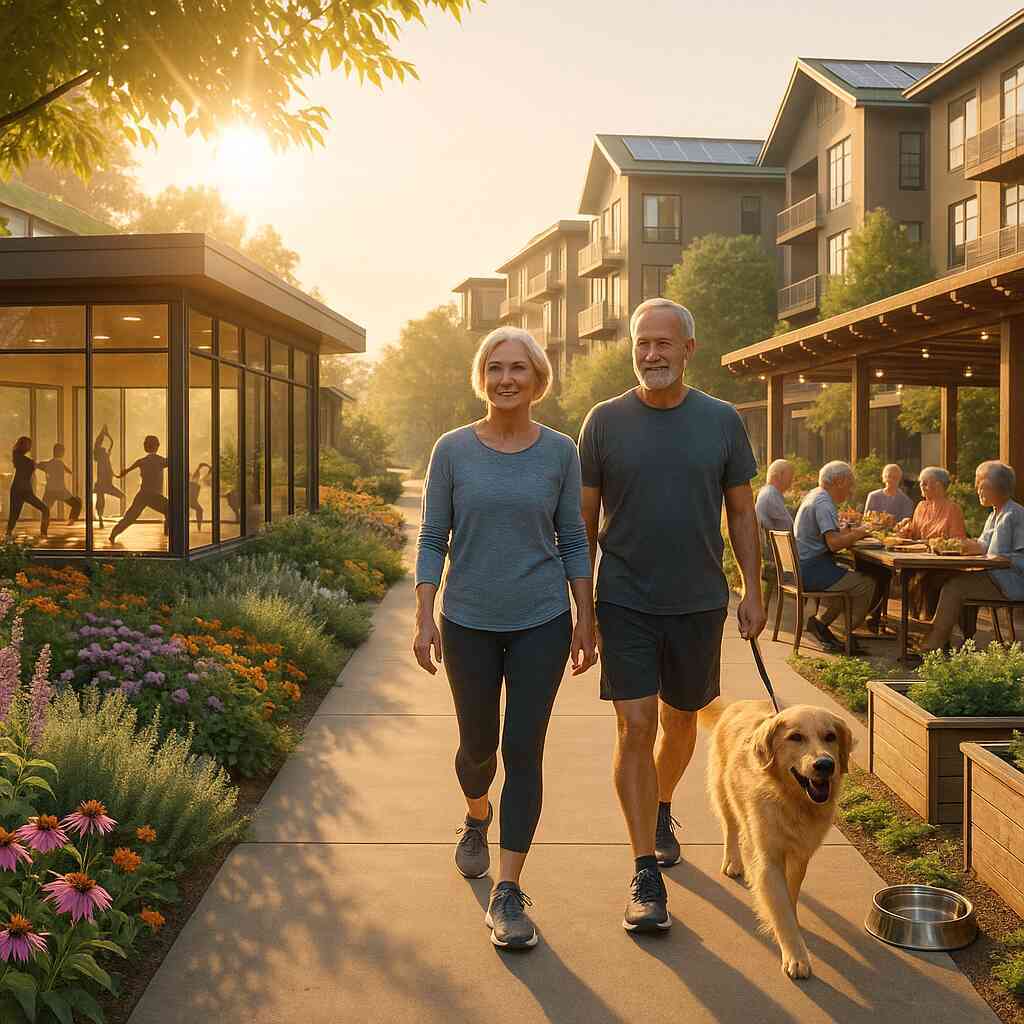
Best Practices for Transitioning to a Senior Living Facility
September 7, 2024
Understanding the Journey Ahead
Defining Senior Living Transition
The transition to a senior living facility is a significant phase in an older adult’s life, encompassing much more than simply moving to a new residence. It involves adapting to a new way of living, integrating into a community setting, and, often, accepting a different level of care. This transitional journey marks a change from independent or home living to a structured environment designed to meet the unique needs of seniors. Understanding this process is crucial for making informed decisions and ensuring a smooth, positive transition for both seniors and their families.
Types of Senior Living Options
When considering a move to a senior living facility, it’s vital to explore the various types of living options available. These include independent living communities for those who are largely self-sufficient, assisted living facilities that provide more personal care and medical attention, and nursing homes or long-term care facilities that offer round-the-clock medical care and support. Each type of senior living caters to different needs, ranging from simple lifestyle changes due to aging to more comprehensive care for health conditions or disabilities. Being informed about senior living facilities and their specific offerings is the first step toward finding the right home.
Evaluating Your Needs and Preferences
Evaluating one’s needs and preferences is a critical step in the senior living transition. This evaluation should consider the level of care required, lifestyle preferences, social needs, and financial considerations. It’s also important to think about proximity to family and friends, availability of preferred amenities, and the type of community culture that would be most enjoyable. Taking the time to assess these aspects thoroughly can help seniors and their families find a senior living option that ensures comfort, happiness, and well-being in the years to come. Making a list of priorities and must-haves versus nice-to-haves can simplify the decision-making process and guide you toward the best choice for your specific situation.
Starting the Process
Searching for the Right Senior Living Facility
The journey towards finding a suitable senior living facility begins with a comprehensive search that is both broad and detailed. With various options available across the country, it is essential to identify one that caters to your specific preferences, healthcare requirements, and lifestyle choices. Initiating this search can seem daunting, but Senior Living Facilities simplify the process, serving as a gateway to a multitude of senior living options, including independent living, assisted living, and nursing homes. By harnessing the detailed information available on our platform, you can make an educated choice, ensuring that the selected community aligns with your long-term living aspirations. Start by envisioning the kind of environment you wish to reside in and consider factors like community size, location, atmosphere, and the level of care provided. This preliminary contemplation will guide your initial steps toward finding your ideal senior living space.
Using Tools and Resources for Finding Senior Living Near You
In the modern digital age, technology plays a crucial role in helping seniors and their families find the perfect senior living community. Tools and resources like the Senior Living Facilities search function enable users to effortlessly find senior living facilities near me, offering a user-friendly way to navigate the myriad of options available nationwide. By inputting your location, you can access a tailored list of communities that meet your geographical preferences. Furthermore, our platform offers detailed descriptions, photographs, and reviews of each facility, providing a comprehensive understanding of what each community offers. This wealth of information empowers families to make well-informed decisions without the need for extensive physical visits, making the preliminary search process both efficient and effective.
Considerations for Location, Care, and Community
Choosing the right senior living community involves a myriad of factors beyond just the aesthetics and amenities. The facility’s location is paramount-proximity to family and medical services, the surrounding neighborhood, and access to cultural or recreational activities can significantly impact daily life and happiness. Furthermore, the level of care provided is another critical consideration. Whether it’s assistance with activities of daily living, specialized memory care, or medical monitoring, understanding the scope of services available helps in aligning the facility with the senior’s current and future health needs. Lastly, the community aspect should not be overlooked. Social engagement, recreational activities, and the overall culture of the community play a vital role in ensuring a fulfilling and vibrant lifestyle. Seniors should strive for a setting where they can thrive, embrace new friendships, and continue engaging in hobbies and interests. By thoroughly evaluating these factors, seniors and their families can make a choice that not only meets practical requirements but also enriches the senior’s life.
Making the Decision
Comparing Senior Living Facilities
When it comes to choosing the right senior living facility, comparison is key. Each facility offers a unique mix of services, amenities, and community atmosphere. To simplify this process on our platform, Senior Living Facilities, families can compare numerous communities side-by-side. Look at factors such as the types of housing options available-from independent senior living to nursing homes-and the levels of care provided. A thorough comparison also involves evaluating how well each facility meets the senior’s lifestyle preferences and healthcare needs. For example, some communities might offer extensive recreational programs that would appeal to active seniors. In contrast, others might provide specialized healthcare services that are crucial for those with specific medical conditions. Remember, visiting each shortlisted facility, either virtually or in person, and talking to staff and residents can provide invaluable insights into what daily life is like in the community.
Assessing Financial Considerations
Understanding and assessing the financial implications is a crucial aspect of transitioning to a senior living community. Seniors and their families need to explore all costs involved, including monthly fees, one-time entrance fees, and any additional charges for extra services. To aid in this, our platform features resources like the article on assessing financial considerations for seniors moving, offering a comprehensive overview of the costs associated with luxury senior living in particular regions, such as Florida. This kind of detailed financial information helps families plan effectively for both immediate and long-term expenses, ensuring the chosen senior living option is sustainable over time. Additionally, exploring available financial assistance programs, insurance coverage options, and potential benefits can also alleviate economic pressures and make the transition smoother.
Involving Family in the Decision-Making Process
Involving family members in the decision-making process is beneficial for both the seniors and their relatives. Having open and honest discussions about preferences, concerns, and expectations can help identify the most suitable senior living option. It’s also important for family members to understand the senior’s wishes regarding the level of care, type of community, and lifestyle they envision in their new home. Utilizing tools like contacting senior living facilities through our website can facilitate these discussions by providing families with the information and resources needed to make informed decisions. Family support doesn’t only offer emotional comfort but also ensures that the selected community aligns with the senior’s needs and desires, creating a sense of shared decision-making that respects the senior’s autonomy and preferences.
Preparing for the Move
Downsizing for Senior Living
Downsizing is a crucial step in the transition to senior living, enabling seniors to simplify their lives and focus on what truly matters. This process involves reducing personal belongings to fit into a potentially smaller living space and adjusting to a lifestyle that requires less maintenance and physical care. Start by categorizing items into those you need, those you want, and those you can donate or sell. Remember, downsizing doesn’t mean losing memories or value; it’s about creating a comfortable, safe, and manageable environment in your new home. Engaging with family members for support during this time can also make downsizing a more enjoyable and less overwhelming process. Consider utilizing digital platforms or having family members help with the sale or donation of items to streamline the process.
Senior Living Moving Checklist
A comprehensive checklist is essential for a smooth move to a senior living facility. Begin by confirming moving dates and details with the new community. Please arrange for a moving service that has experience with senior transitions, ensuring they understand the specific needs and concerns that come with moving at an older age. Notify utilities, healthcare providers, banks, and other important contacts about the change of address. Packaging should be done thoughtfully, with clearly labeled boxes for easy unpacking. Important documents and medications should be kept accessible. Consider the ultimate guide to senior housing in Texas 2024 as a resource for understanding the finer points of relocating within specific regions, including utility setups, local amenities, and other logistical considerations particular to the area.
Emotional Preparation and Support
Transitioning to a senior living community is not just a physical move but an emotional journey as well. It’s normal to feel a mix of emotions, from excitement about new opportunities to sadness about leaving a long-time home. Engagement in open discussions with family, friends, and future neighbors can ease the transition. Many senior living communities offer resources and programs to support new residents emotionally, helping them to acclimate to their new surroundings and connect with the community. Developing a positive mindset about the move, focusing on benefits like reduced home maintenance, increased safety, and access to care and social activities,, can also aid in the emotional adaptation process. Emotional preparation is as critical as the physical aspects of moving, ensuring a smooth, comfortable transition into this new chapter of life.
Adjusting to Life in a Senior Living Community
Transitioning to a senior living environment brings about a significant lifestyle change that requires both physical and emotional adjustments. Adapting to a new community, forming new friendships, and getting accustomed to the routines can take time but are crucial for a fulfilling living experience. In this section, we delve into making the transition smoother and more rewarding for new residents.
Tips for Seniors Moving
The experience of moving to a senior living facility can be overwhelming for many seniors, given the emotional and physical toll of transitioning from a long-term home to a new environment. To make this process smoother, it’s imperative to plan. Start by researching and visiting potential communities, such as seniors living in California, to find the one that feels most like home. Furthermore, simplifying the move by downsizing possessions can not only ease the transition but also adapt more quickly to the new living space.
Once you move in, personalize your living area with familiar items to make it feel more like home. Photos, favorite books, and personal decorations can help transform an unfamiliar space into a comforting haven. Additionally, maintaining regular communication with family and friends during the initial phase can provide emotional support and ease feelings of isolation or loneliness.
Easing into Social Activities and Community Life
Integrating into the community and participating in social activities are pivotal aspects of embracing life in a senior living community. Most facilities offer a wide range of senior living amenities that enhance daily life, from arts and crafts classes to group outings and movie nights. Engaging in these activities can significantly aid in the transition by providing opportunities to meet neighbors, form new friendships, and maintain an active lifestyle.
It might take some time to feel comfortable participating in communal activities. Start small by joining a group that matches your interests or hobbies. Whether it’s a book club, gardening group, or fitness class, engaging in familiar activities can make the transition into community life smoother and more enjoyable. Residents who take an active role in their community often find it easier to adjust and feel a sense of belonging more quickly.
Adapting to Assisted Living
Adapting to assisted living involves adjusting to a lifestyle where personal care and health monitoring are readily available. This transition can be challenging, particularly for those who have been highly independent. Understanding and accepting the level of care provided is crucial for a smooth adjustment. Facilities typically offer customized care plans that cater to individual needs, ensuring each resident receives the appropriate level of support while also promoting independence.
For many seniors, the transition to assisted living is an opportunity to relieve the stresses of daily chores and health care management. Embracing the safety, support, and care that assisted living facilities provide can lead to improved quality of life. Regular conversations with staff and other residents who have undergone similar transitions can offer helpful insights and reassurance.
Remember, adjusting to life in a senior living community takes time and patience. It’s an ongoing process of discovery, adaptation, and personal growth. By engaging with the community, maintaining an open mind, and asking for help when needed, seniors can navigate this transition successfully, laying the foundation for a comfortable and rewarding chapter of their lives.
Ongoing Support and Resources
Utilizing Available Senior Transition Services
Transitioning to a senior living community is a significant life event that can be made smoother with the right support and resources. Recognizing this need, many senior living facilities offer transition services specifically designed to aid seniors and their families during this time. These services can range from personalized moving assistance to emotional support. On platforms like Senior Living Facilities, seniors and their families can find comprehensive guides and senior living blog articles filled with tips on making the transition as seamless as possible. Utilizing these services can alleviate the stress associated with moving, ensuring seniors feel welcomed and supported from day one in their new home. By taking advantage of transition assistance, seniors can navigate the practical and emotional challenges that accompany this change, helping them to acclimate more quickly to their new surroundings.
Engaging with Community and Support Groups
Once settled into a new senior living community, one of the most beneficial steps a senior can take is engaging with community and support groups available on-site. These groups serve as invaluable resources for newcomers, providing a platform for social interaction, emotional support, and mutual understanding. Many communities for seniors offer a variety of social clubs, interest groups, and support circles designed to cater to the diverse needs and interests of their residents. Participating in these groups can significantly enhance a senior’s quality of life by fostering new friendships, encouraging active participation in hobbies and activities, and building a sense of belonging within the community. Moreover, support groups provide a space for residents to share their experiences, coping strategies, and advice on adjusting to life in a senior living setting, making the transition smoother for everyone involved.
Accessing Health and Wellness Services
A crucial aspect of adapting to life in a senior living community is taking full advantage of the health and wellness services offered. These facilities are equipped with resources to support the physical and mental well-being of their residents, ranging from medical care to senior citizens performing balance exercises and wellness programs. Engaging in regular physical activity, attending health seminars, and utilizing on-site medical services can play a significant role in ensuring seniors’ health and happiness. Wellness services may include nutritional guidance, fitness classes designed for senior mobility and various forms of therapy to address emotional well-being. By actively participating in these services, seniors can maintain or even improve their health, contributing to a more fulfilling and enjoyable lifestyle in their new community. Adopting a proactive approach to health and wellness not only benefits the individual senior but also contributes to the overall positive environment of the senior living facility, creating a culture of care and support.
Looking Forward
Transitioning to a senior living facility is not the final step in adapting to a new phase of life; it’s a dynamic process that continues as seniors settle into their new homes. Planning for the future, maintaining vital social connections, and exploring new hobbies are all important aspects of thriving in a senior living community.
Planning for Future Care Needs
One of the most critical components of living comfortably in a senior living community is the ability to plan for future care needs. As seniors age, their health and care requirements can change, necessitating adjustments in the level of support they receive. Proactive communication with facility staff and healthcare providers ensures that any transition in care is smooth and stress-free. Seniors and their families should regularly review care plans and stay informed about the services available within the community. By anticipating and planning for these changes, seniors can enjoy peace of mind, knowing that their care needs will be met now and in the future.
Maintaining Connections with Family and Friends
The importance of maintaining connections with family and friends cannot be overstated, especially after transitioning to a senior living facility. Regular visits, phone calls, and technology-facilitated interactions, such as video calls, can keep these relationships strong. Many senior living communities encourage family involvement through events and activities designed for residents and their loved ones. Such interactions not only reinforce emotional bonds but also provide seniors with continued links to their life outside the retirement home, enhancing their overall well-being and happiness.
Exploring New Hobbies and Interests in the Community
Senior living communities offer a wealth of opportunities to engage in new hobbies and interests, which can be especially enriching for seniors. From art classes and gardening clubs to book discussions and fitness training, there’s typically a variety of activities designed to meet a wide range of interests and abilities. Exploring these options can lead to the discovery of newfound passions and contribute significantly to a senior’s quality of life. Trying something new also presents the chance to socialize, make friends, and integrate more fully into the community, helping seniors feel more at home in their new environment. Engaging in independent senior living activities fosters a sense of autonomy and personal growth, key components of a satisfying and vibrant retirement.
In conclusion, the journey to and through a senior living facility is multifaceted and ongoing. By planning for the future, maintaining important personal relationships, and remaining open to new experiences, seniors can make the most of their time in a senior living community. These strategies not only improve the quality of life but also support a fulfilling, engaging, and enjoyable retirement.
Frequently Asked Questions
Question: What types of senior living facilities can help with transitioning to assisted living?
Answer: Senior Living Facilities offers a wide range of communities designed to support seniors in transitioning to assisted living. Our platform features a comprehensive selection of assisted living locations, each providing tailored care and support to meet the specific needs of older adults. Whether you’re seeking assistance with daily activities, specialized memory care, or medical monitoring, our network includes facilities that offer the full spectrum of care options. By comparing assisted living plans and services on our platform, you can find the perfect setting that ensures comfort, safety, and a high quality of life during the transition.
Question: Can Senior Living Facilities assist in downsizing for a move to a senior living community?
Answer: Absolutely. Senior Living Facilities recognize the challenge of downsizing when preparing for senior living. Our platform provides resources and tips for seniors moving, including how to downsize personal belongings effectively. We understand the emotional and physical aspects of this process and aim to make it as smooth as possible. In collaboration with various senior relocation services, we can connect you with professionals who specialize in helping seniors organize, downsize, and move their possessions in preparation for their new home in a senior community transition.
Question: How do Senior Living Facilities support the emotional well-being of seniors during the transition to a new living environment?
Answer: Our commitment to the well-being of seniors extends beyond just finding a new home. We provide emotional support for the senior transition by offering access to counseling services, support groups, and educational resources about coping with change. Senior Living Facilities understands the emotional challenges that come with transitioning to a senior living facility. Thus, we strive to connect individuals and their families with senior transition services that offer guidance, support, and reassurance throughout this significant life change. By fostering a sense of community and belonging, we help ensure seniors feel welcomed and valued from the moment they decide to make the transition.
Question: In the blog post “Best Practices for Transitioning to a Senior Living Facility,” what strategies are mentioned for easing into senior living?
Answer: The blog post emphasizes several strategies for easing into senior living, highlighting the importance of planning, engaging with community activities, and adapting the living space to feel like home. Senior Living Facilities encourages seniors and their families to start by researching and visiting potential communities, allowing time to find the perfect fit. Upon moving, it’s recommended to personalize the living area with familiar items to create a comforting environment. Additionally, participation in social activities and community life is strongly encouraged to foster new friendships and maintain an active lifestyle. These strategies, combined with our platform’s resources and support, aim to make the transition smoother and more enjoyable for seniors adapting to their new community.
Question: What kinds of resources do Senior Living Facilities provide for families planning a senior living move?
Answer: Senior Living Facilities offers a wealth of resources for families embarking on the journey of transitioning a loved one to senior living. Our platform features detailed guides on different housing options for seniors, including assisted living locations and nursing homes for the elderly. We provide a senior living moving checklist, tips for downsizing, and strategies for emotional preparation. Additionally, our comprehensive search function allows families to find “senior living near me” that matches their specific preferences, care needs, and financial considerations. Through our guides and articles, families can gain insights into assessing community amenities, understanding care plans, and managing financial implications, all geared toward making informed decisions for their loved ones.




